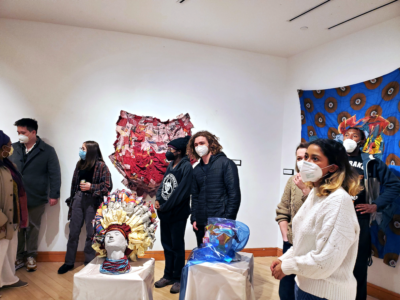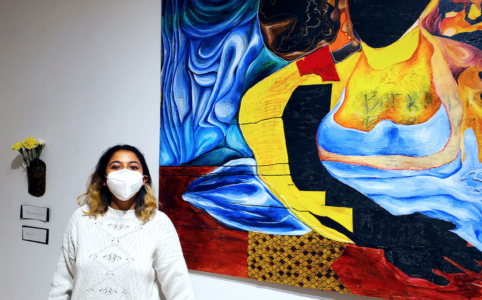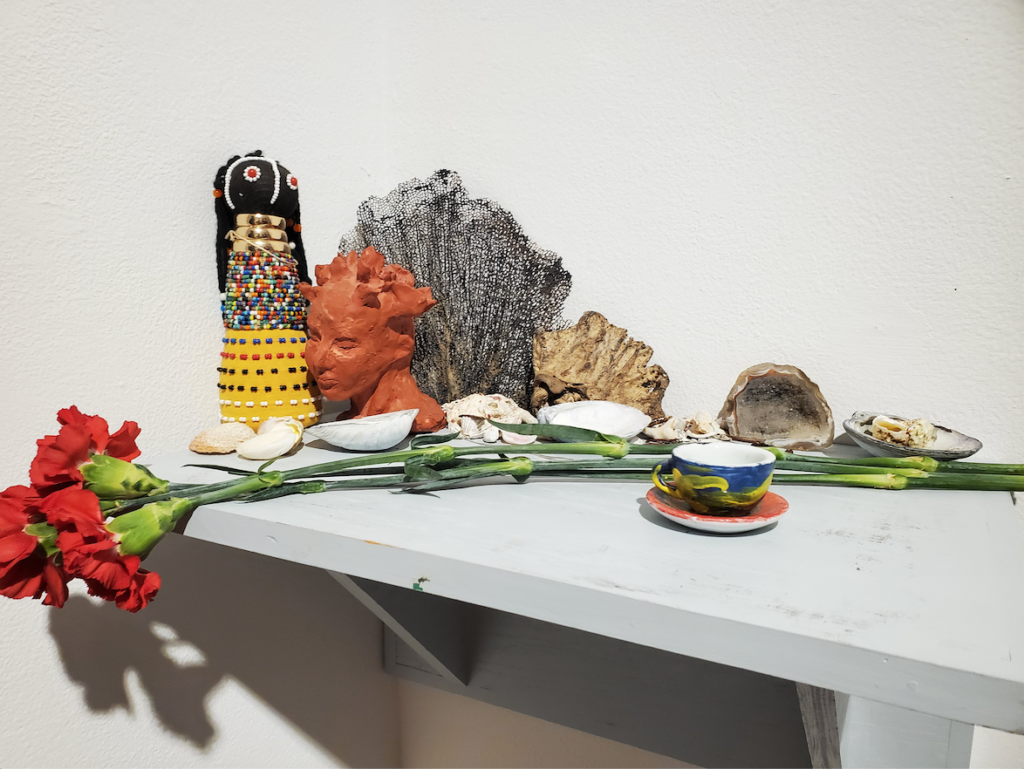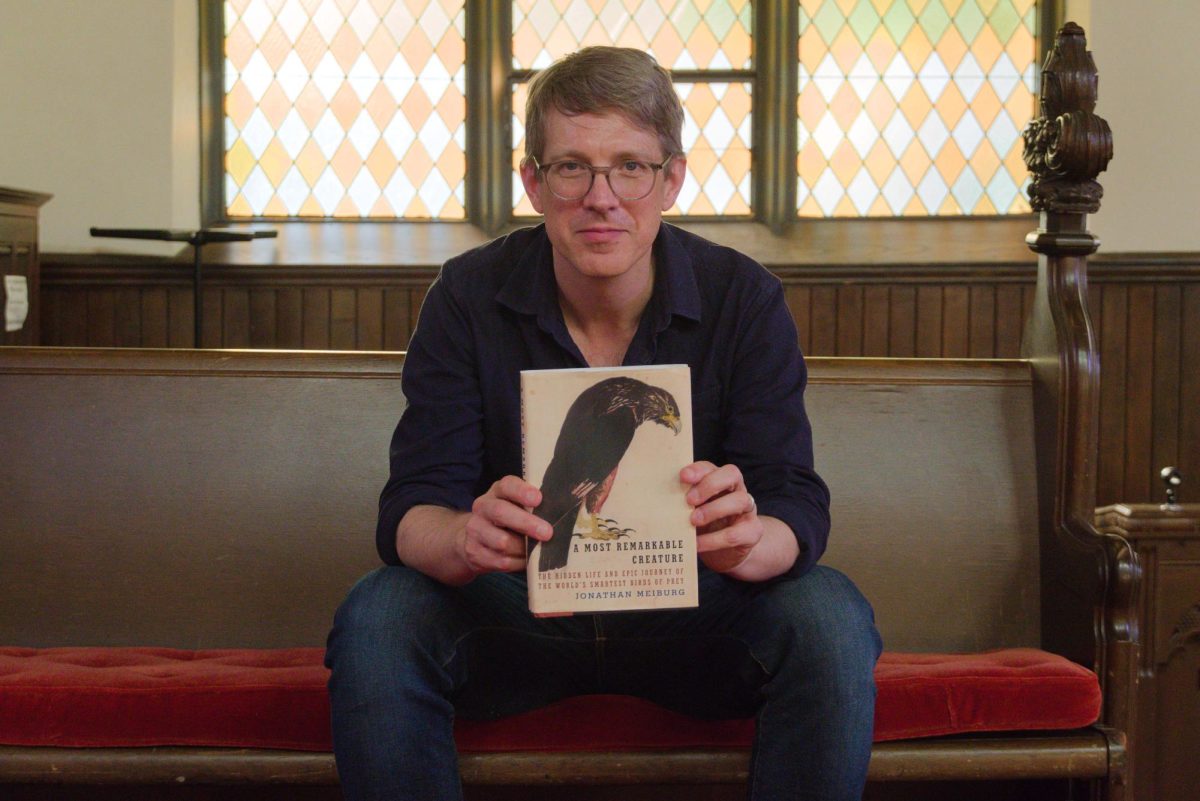Before the Spanish colonized the Caribbean in the 15th century, the Taíno people were the principal inhabitants of Puerto Rico, Jamaica and the Lesser Antilles. The Taíno peoples held a strong artistic tradition and thrived on matrilineal systems of kinship and inheritance. However, at the hands of Spanish imperialists, 90 percent of the Taíno population were destroyed over the next two centuries from slavery, violence and foreign illness. Today, descendants of the Taíno live across the Caribbean, Puerto Rico and the Southern United States, grappling with a history colored by settler colonialism and cognizant of their legacy of strength and resistance.
Grinnell College’s latest Smith Gallery exhibition “The Divine Feminine: Black and Taíno Sacred Bodies,” calls attention to this complex colonial history and celebrates the resilience of women from the Afro-Caribbean and Taíno Diaspora.
The vibrant multimedia exhibit, crafted by Paula Maria Persiani `22, consists of two altars of flowers, sculptures, beads and assorted meaningful items; two sculpted heads with ornate headdresses; two paintings; a flower vase wall sconce; and two intricate textile pieces.
An explanation by the entrance to the Gallery reads:
“This exhibit is a shrine to all the Black and Taíno women — those now gone who resisted and assisted in our spiritual ascent so that we can push forward towards freedom, and those of us that are here.”

Persiani said she drew inspiration for her artwork from the polytheistic religion of Santeria, an Afro-Caribbean religion drawn from Yoruba spirituality and Roman Catholicism. The name “The Divine Feminine” originated when Persiani read the book “Orishas, Goddesses, and the Voodoo Queens: The Divine Feminine in the African Religious Traditions,” by Lilith Dorsey. Persiani said the three female deities in the book struck her as powerful.
“It’s just kind of like, how do I explore my own divine feminine within my art and within my life?”
Persiani is from the predominately Black and Latino neighborhood of Washington Heights, New York City and has family in Puerto Rico, where Santeria is practiced. Throughout her childhood, her mom exposed her to Puerto Rican foods, music and people. When Hurricane Maria hit Puerto Rico in late 2017, while Persiani was a senior in high school, she felt moved to learn more about Puerto Rican history. When Persiani came to majority-white Grinnell, she said she felt separated from her Puerto Rican and Afro-Caribbean culture.
“I wanted to create a space for myself and for other people who have the same background as me,” Persiani said. “Especially in Grinnell.”
The conflagration of Puerto Rican history, exploration of feminine power and a yearning for community united to inspire the artwork in “The Divine Feminine.”
“Womb” is one of the show’s seminal pieces The lush, textural handcrafted quilt stitched with mixed and matched red and pink fabrics cascades from the left wall of the small Smith Gallery space; both bottom edges are pinned backward, causing the fabric to bulge three feet outward, like an immense womb. The piece represents the emotional trauma from the disturbing history of women’s reproductive rights in Puerto Rico; between 1930 and 1970, nearly one-third of Puerto Rican women were forcibly sterilized.
“I made the piece almost severed, but then I also re-stitched it,” Persiani said, “because we’re still trying to stitch all the things together, trying to keep our communities safe.”

In one painting, indecipherable blue letters appear under a stark yellow wash. When the canvas was empty, she decided to write “Racism is over; racism is not over,” repeatedly until the phrases filled the entire canvas. The words were “an expression of uncertain anger, because I’m not really certain who to be angry at,” Persiani said, in reference to prevailing racism in the United States today.
After writing the phrase on the canvas, she painted over the text with bright blues, reds and yellows. Now, the completed painting in the exhibit portrays an abstract woman without a face, reaching her right arm in front of her. Much of Persiani’s work in the show utilizes mixed media, from vinyl and recycled fabrics to live flowers.
Persiani said she hopes visitors who did not know of the history of the Taíno people or Santeria will now approach the history and people of Caribbean and Puerto Rico with new, complex lenses in mind. However, she also wants visitors to leave with a sense of strength and warmth.
“I want them to feel full of color, saturation and vibrancy.”
“The Divine Feminine” opened on April 17, 2022. The Smith Gallery in the Joe Rosenfield Center will host the exhibit until May 1.


























































